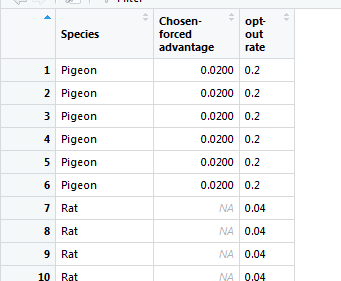I am not sure why this error keeps popping out
my data looks like this:

my code is as below:
boxplot(split(Figure1$
opt-out rate,Figure1$Species))
Error in x[floor(d)] + x[ceiling(d)] :
non-numeric argument to binary operator
I am not sure why this error keeps popping out
my data looks like this:

my code is as below:
boxplot(split(Figure1$
opt-out rate,Figure1$Species))
Error in x[floor(d)] + x[ceiling(d)] :
non-numeric argument to binary operator
It is always a good idea to have a reproducible example. It helps us help you. Here you can read more about how to do it:
That being said, in your case I'm pretty sure the problem is that your column name (specifically, opt-out rate) is not a valid name, so R is getting confused.
To fix this, you can do the following:
make.names function in base R.Figure1$`opt-out rate`
Did you paste the code exactly as you are running it? Because when I try to run the code (mocking up your data frame as best I could), I'm getting a different error due to the syntactically invalid name:
# Create some fake data with a similar format as the real data
Figure1 <- data.frame(
Species = c(rep("Species1", 5), rep("Species2", 5)),
`opt-out rate` = rbinom(10, 10, 0.5)/10,
`Chosen-forced advantage` = c(rep(0.002, 5), rep(NA, 5)),
check.names = FALSE
)
boxplot(split(Figure1$opt-out rate,Figure1$Species))
#> Error: <text>:9:31: unexpected symbol
#> 8:
#> 9: boxplot(split(Figure1$opt-out rate
#> ^
Created on 2018-07-21 by the reprex package (v0.2.0).
Have you taken a look at this community's recommendations for asking questions about R code? The example above shows a couple of strongly recommended practices: including sample data (screenshots can't be easily run!) and using the reprex package to format examples, which shows both the code and the output.